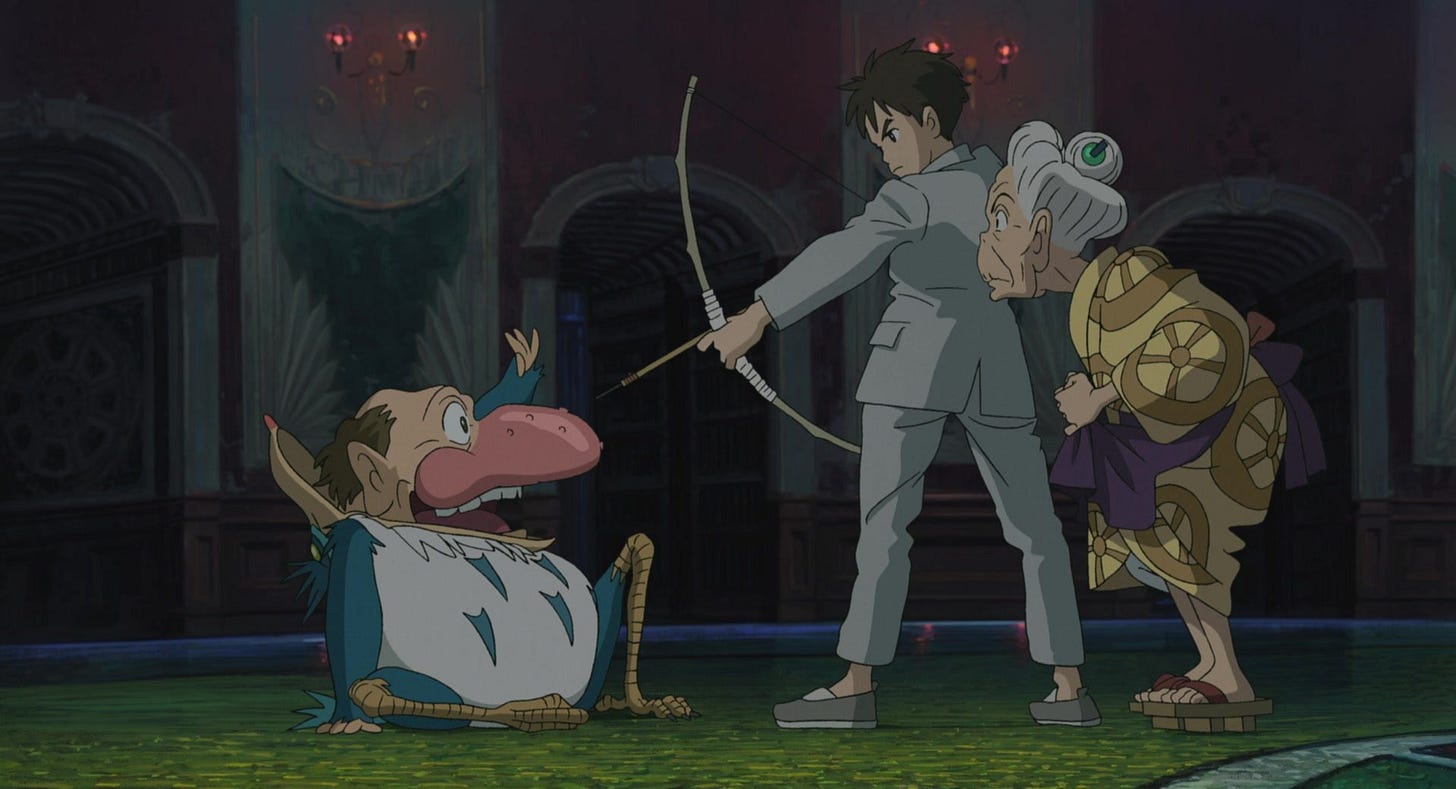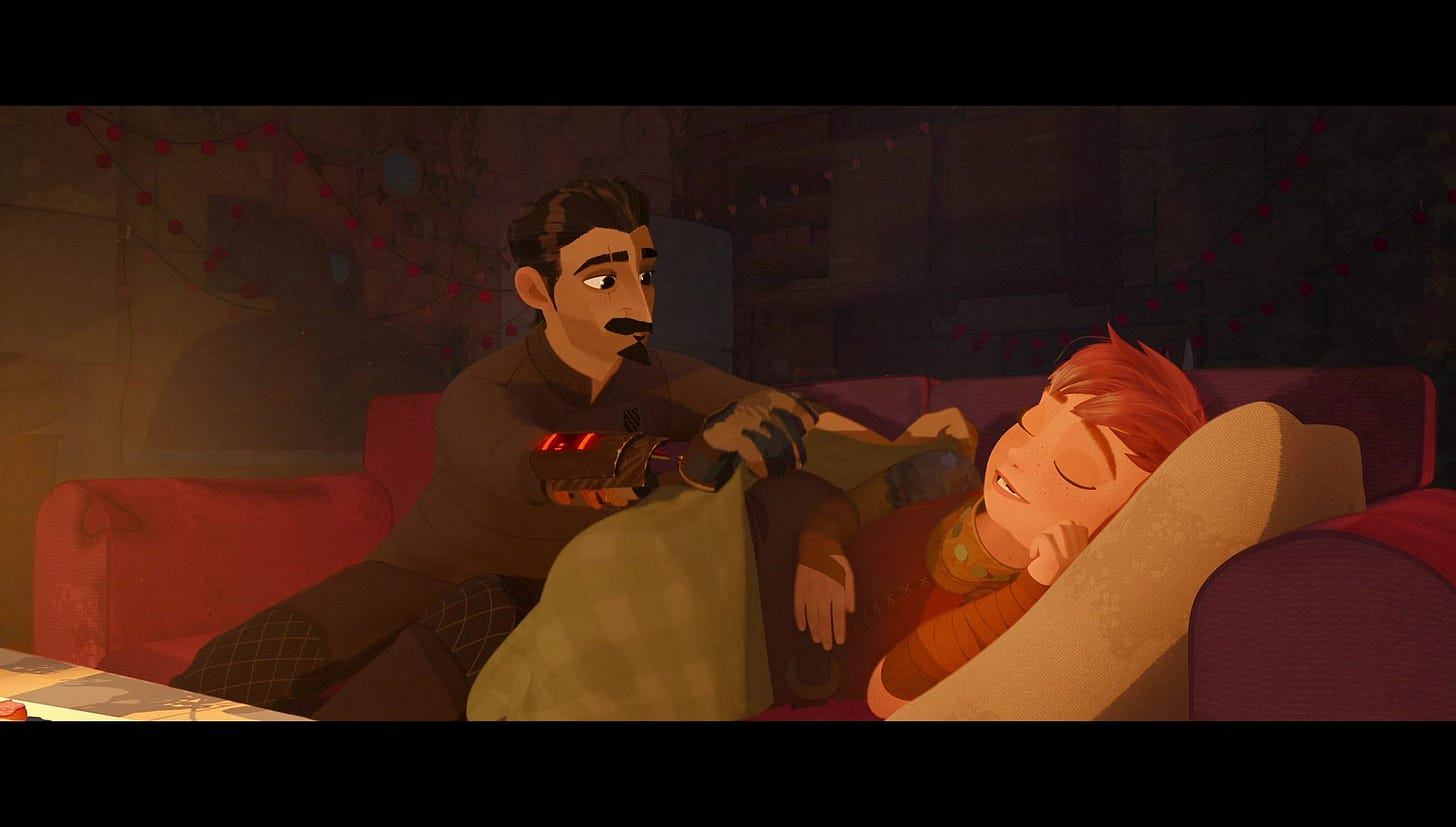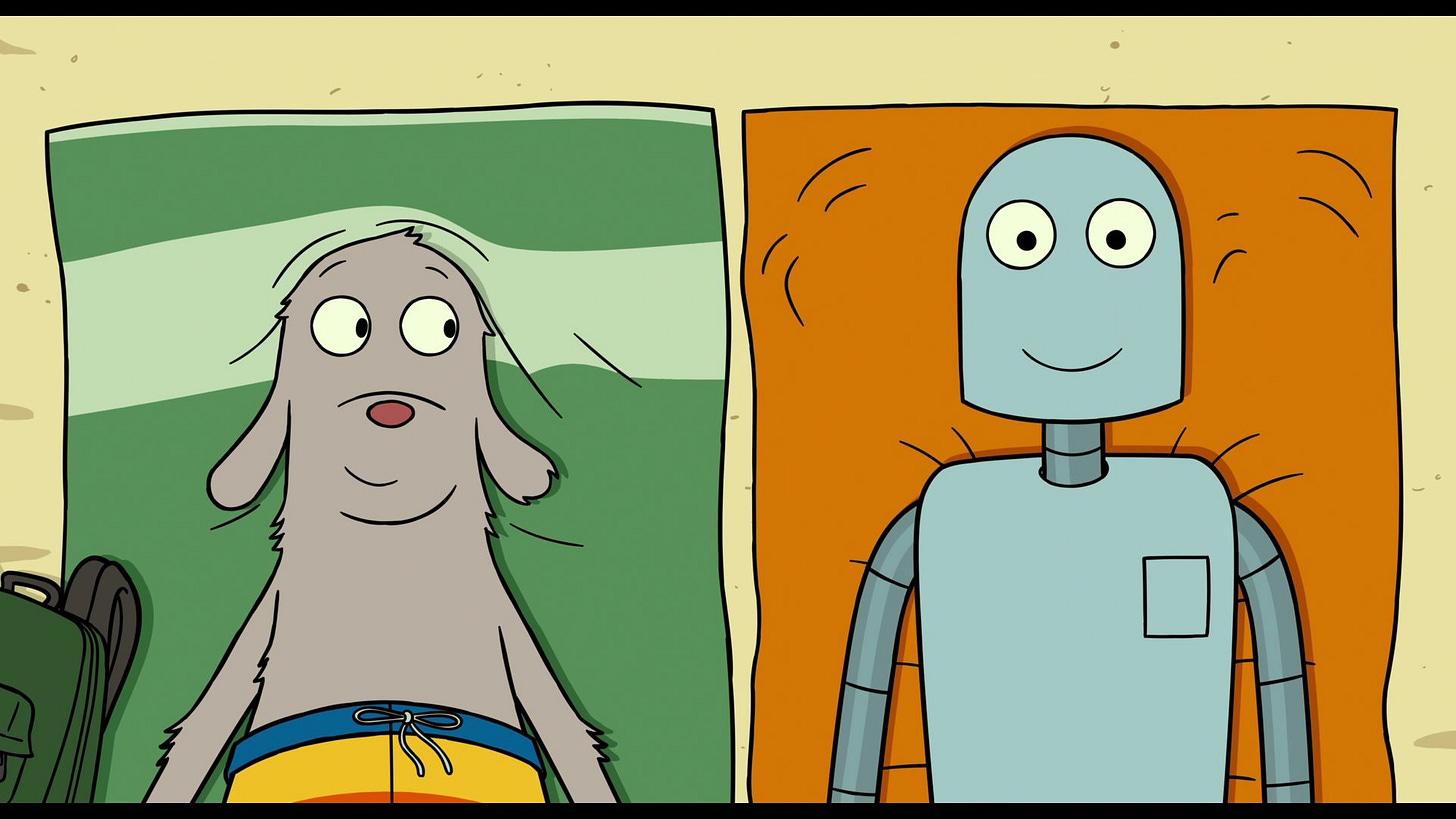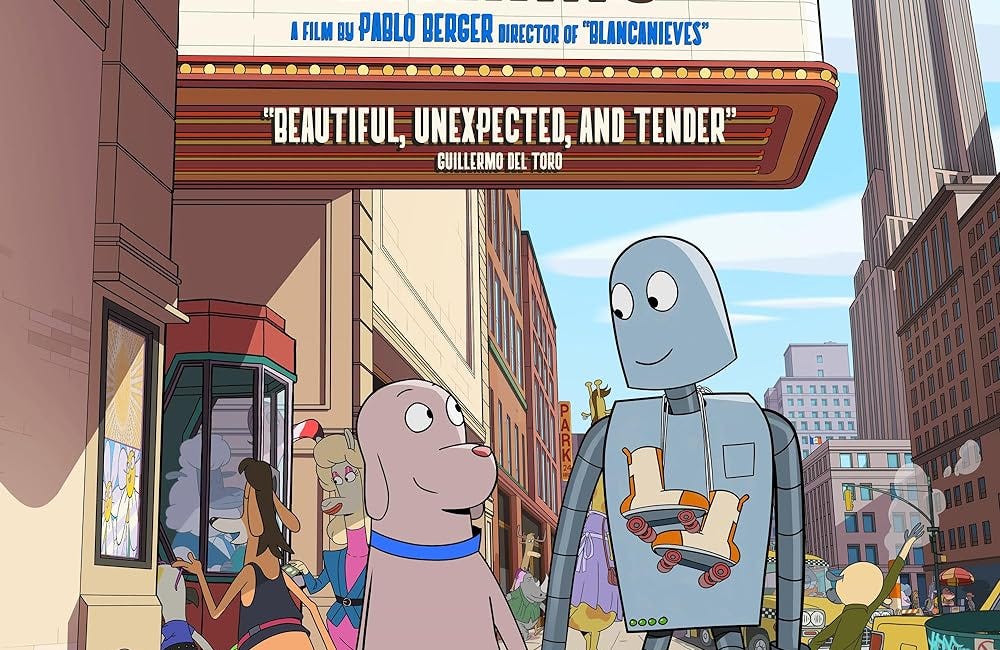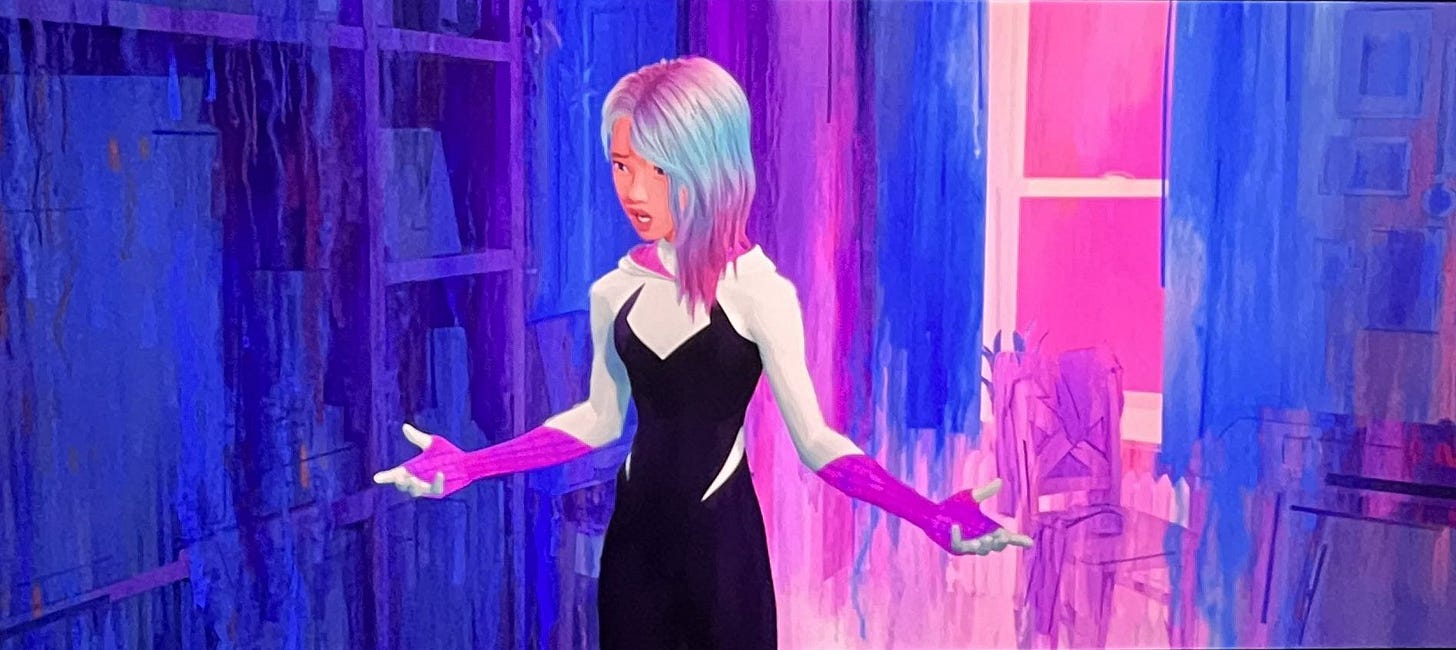This post may be too long for email. We recommend clicking through to the website for the best experience.
Eli: 2023 marked an important milestone in animation: the 100th birthday of Walt Disney Animation Studios! Naturally, they pulled out all the stops to celebrate, crafting a feature film sure to dazzle millions and show audiences and critics why they’ve been the kings of animation for a century. And then they threw that movie in the trash and released Wish. Perhaps Disney’s worst effort since the Wartime Era, Wish was not nominated for Best Animated Feature this year.
Elsewhere, Illumination managed to get the Super Mario license from Nintendo, and the result was The Super Mario Bros. Movie, a star-studded vehicle that became the first video game movie to gross over a billion dollars. Despite being based on one of the most recognizable media properties in existence and including a song that somehow charted higher than anything from Wish (“Peaches” reached #56 in the US), The Super Mario Bros. Movie received mixed reviews and was also not nominated for Best Animated Feature this year.
That’s two humongous products that didn’t make the cut. And all for the better, because the five films that did are all outstanding. After all we’ve been through in this series, 2023 feels like a culmination. In 2001, the first year of Best Animated Feature, you could basically get a nomination just for including 3D animation in your movie. In the early years of the award, megastudios dominated the shortlists because they dominated the medium. Nowadays, not only has feature-length animation become so widespread that tons of different creative teams are producing incredible work, but critics (and the Academy) have also grown to appreciate the variety in animation and aesthetic styles on offer. Disney, Pixar, and DreamWorks still have their high points, but those high points no longer define animation. And that’s a good thing.
Obviously it’s pure coincidence that we just so happened to start this project directly after one of the most stacked years (if not the most stacked year) in the history of the award, but it still makes for a great finale…for now.
The Nominees
The Boy and the Heron (won Best Animated Feature)
Elemental (nominated)
Nimona (nominated)
Robot Dreams (nominated)
Spider-Man: Across the Spider-Verse (nominated)
The “Best” Animated Feature: The Boy and the Heron
Leah: Longtime readers already know how much I love Studio Ghibli. It’s hard for me to point to an animation studio that has had more consistently high-quality output than Ghibli. The Boy and the Heron was their first theatrical release since 2015, so of course it was very hyped up, especially as the latest return from retirement for legendary director Hayao Miyazaki.
The Boy and the Heron follows Mahito, a young boy whose mother died during an air raid in World War II. His father remarries his mother’s younger sister and moves Mahito out to her estate. It’s a difficult adjustment for him. To make matters worse, a heron that lives around the estate starts talking to him, leading him toward an abandoned tower, telling him that his mother is still alive and he knows where to find her. The tower takes him into a different world, sending him on a journey that makes up the bulk of the film.
Describing the plot of the film in full would take up too much space, and I don’t think my words would do it justice. It’s best experienced for yourself. The Boy and the Heron is a film about grief and legacy, figuring out how to live through life’s tragedies. The film tells its story in symbolic and abstract ways, ultimately leaving the interpretation up to the viewer.
The animation in the film is absolutely gorgeous. The opening sequence was particularly striking upon my most recent viewing. It’s nice to see that hand-drawn animation still has a place in the industry, and that a movie like The Boy and the Heron can be recognized as an achievement of the medium.
This movie is another positive addition to Miyazaki’s filmography, continuing to build on his lifetime of filmmaking. I think this movie meant more to me after having watched all the previous Ghibli films he’s directed. His films are cohesive thematically, and considering them as a body of work makes each individual film feel richer. Especially with The Boy and the Heron’s themes of legacy, there’s a very meta way the film can be interpreted.
With all that said, 2023 was an incredibly stacked year for Best Animated Feature nominations (I think the floor is a 9/10 this year). How do the other nominees stack up against this hand-drawn masterpiece?
The Other Animated Features
Elemental — Eli
Nominated
Y’all ever come across a movie that just makes you feel like an idiot?
I don’t even like calling people idiots, especially not myself, but I cannot think of any other way to describe my relationship with Elemental relative to the general critical consensus. Most people agree this was a flop, a mediocre offering that perfectly exhibited the pitfalls Pixar has succumbed to on its gradual decline from the cutting-edge trailblazer of Western animation it once was to the washed-up also-ran it has become. It’s averaging 3.3 stars on Letterboxd, which puts it lower than every original Pixar has ever released except for The Good Dinosaur (2.9)—even Onward (3.4), which had the unique disadvantage of releasing in March 2020. It’s lower than a lot of the Pixar sequels most everyone agrees didn’t even need to exist: Monsters University (3.4), Incredibles 2 (3.4), Toy Story 4 (3.4), tied with Finding Dory (3.3).
And all I can say is…really? Really? This movie is worse than Incredibles 2? Is this some kinda sick joke? Are people just fed up with Disney/Pixar? Is this a protest campaign? Were people too swayed by the movie’s horrendous marketing?
Or…is something wrong with me for really loving this movie? Am I a simple-minded slop eater? Have I lost my ability to analyze media? Am I unfit to be a critic?
I can agree it’s not a perfectly executed movie, though I did give it a 10/10 for Pixar Pints and retain that opinion upon rewatch. Some of the humor is a miss, the love story aspect is set up a little too quickly, and the big kiss is replayed three times at different zoom levels to unintentionally hilarious effect. There’s a lot you could still do to make Elemental a better version of itself. But none of that, to me, is the point. What Elemental actually sets out to do, it does in a manner pretty nearly perfectly for a big-budget Western animated movie aimed at kids.
Most evidently, it tackles systemic racism in a way that makes it clear the creative team actually knew what they were talking about. The Fire people, obviously a stand-in for Asian immigrants, came to Element City in a wave of in-migration a couple generations ago, carrying with them a vibrant culture and celebrated traditions. Despite this, they are generally looked down upon, regularly microaggressed against, and often seen as a threat. Their neighborhood, Firetown, is relegated to a dingy corner of Element City that has fallen into disarray and is at an extremely high risk of natural disaster due to government ignorance and oversight. As a result, the Fire people are proud, insular, and naturally distrustful of other elements, even when they mean no harm. All of this is correct. I saw so many reviews say this movie was derivative of Zootopia (3.7) and it makes me want to tear my fucking hair out because that movie got pretty much all of its racism allegories wrong and this one hit them on the nose. Sure enough, that movie was directed by two white dudes (Byron Howard and Rich Moore) and this one was directed by a second-generation Korean immigrant (Peter Sohn).
Ember struggles with breaking from (what she believes to be) her father’s expectations for her because she understands that he deserves to be repaid for the great sacrifice he made just to build their family’s life in Element City. That theme could stand on its own without tying into a narrative about immigration, but it’s a huge aspect of a lot of second-generation immigrant stories and it’s clear Sohn’s personal experience with the material made its way into the impassioned final product.
The love story between Ember and Wade hardly even needs to be judged as a love story in my eyes. What Ember and Wade seek from each other is not love but inspiration. She needs him to help her understand that what she’s feeling is completely natural, that she is her own person, and that it’s worth expressing her desires to her family. He needs her to drag him away from the ennui-filled depression of a life he lives as the sheltered adult child of a rich family. In the end, both of them find what they were looking for. The fact that their arc also plays out as a B-tier love story is merely window dressing.
Sneakily, the most interesting thing about Elemental to me is the emotions it lets its two lovebirds express. Ember is a rage-filled woman who routinely loses her cool; Wade is an emotional man who can basically cry on command. This is obviously swapped from traditional, patriarchal gender roles, but neither character’s family overtly treats either as unnatural. Ember’s father wants her to corral her temper for business reasons but is thoroughly understanding of why she emotes this way; meanwhile, Wade’s emotions of weakness are explicitly encouraged by his family. It’s not often a movie from a children’s animation giant effectively breaks down gendered constructs in such a subtle way—another point in Elemental’s favor, though the movie played Wade and his family’s emotions for laughs a little too much for my liking.
I haven’t even touched on the visuals, which adhere to your typical Pixar standard of excellence. I only bring them up because it’s clear that the general public thinks Pixar’s aesthetic has gotten stale. While I’d agree that they’re not exactly pushing the medium to new heights anymore, I could never go as far as saying their recent work looks bad or even uninspired. Consider the rest of the 2023 Best Animated Feature nominees. Sony is obviously an outlier performer with Across the Spider-Verse, but Robot Dreams is primitive, Nimona is a glued-together patchwork from multiple studios, and what did The Boy and the Heron do that we haven’t seen in a dozen Ghibli movies before it? I know Pixar used to be the industry leader in this department, but expecting infinite growth is unrealistic. It’s perfectly acceptable to settle into a niche and fill it very well, and that’s what Pixar has done in the past decade, including on Elemental.1
So yeah. I love Elemental, and while I’ve never pretended that I don’t, I’m still tired of it. But The Boy and the Heron is strong competition: it’s Hayao Miyazaki’s magnum opus, after all! Surely it’s gotta be better than a middling Pixar film, right?
Well…no, not really. Don’t get me wrong, it’s a great movie. Extremely beautiful and powerful, does a ton well thematically, memorable score, the whole nine yards. The problem with it is that it’s a 124-minute movie that should be a 90-minute movie. So many scenes and shots linger for far too long, the first act goes on forever, and it’s not until nearly halfway through the movie that the titular boy and heron actually start advancing the plot. Fans of the movie, or of Miyazaki, may disagree and say that everything it/he does is for a reason,2 but I fully believe that you could cut about a quarter of this movie and have the same movie.
To me, one of the greatest offenses anyone or anything could perform is to waste my time.3 The Boy and the Heron does. Elemental does not. Even if its themes didn’t speak more to me personally, I’d call it the better movie on that tenet alone.
Verdict: Better Animated Feature
Nimona — Preston
Nominated
Let’s get the roughest bits out of the way first—Nimona definitely does. The first act of this movie is…a mess, honestly. I wanted to say “a bit of a mess” there, but I feel like that’d be underselling it. Not all of the film’s worst offenses are contained to the opening half-hour or so, but most of them are at their worst here: flat characters, bewildering pacing, disjointed timeskips, a lengthy scene to establish the dynamic between the main characters that you realize within about ten minutes was almost completely unnecessary…it’s bad. Not horrendous or anything, because there’s still a lot in here that ends up making the rest of Nimona pretty great—but the vibes are probably best described as “pilot episode of DreamWorks tie-in TV series,” which is not where you wanna be with a feature-length film.
It does pick up, though. Once the main characters—disgraced knight Ballister and chaos-causing shapeshifter Nimona—become a proper duo, everything starts to flow a lot more easily. There are still some iffy pacing moments (what’s even going on in the entire second half of the second act?), but generally the story holds up. The structure of the movie peaks at simply executing a pretty obvious plot well, but the narrative of Nimona isn’t really intended as the highlight of the work. The setting and most of the characters aren’t, either.
A lot of this movie, to put it bluntly, is set dressing for Nimona. She’s obviously the heart of the story, and her character arc is magnificent; I’d put it up there against Across the Spider-Verse’s Gwen as the best of any film I’m covering for this year, and the number of characters written this well in everything I’ve reviewed throughout this series can probably be counted on one hand. ND Stevenson, who wrote the 2015 graphic novel on which the film is based,4 has spoken at length about how Nimona’s internal conflict about being seen as a monster reflects trans and gender-nonconforming identity,5 and I’m not sure I’ve ever seen that struggle captured more eloquently in media.
“Kids. Little kids. They grow up believing that they can be a hero if they drive a sword into the heart of anything different. And I’m the monster? I don’t know what’s scarier. The fact that everyone in this kingdom wants to run a sword through my heart…or that sometimes, I just wanna let ’em.”
Everything about Nimona rocks. She brings an unbelievable amount of energy, depth, and emotion to this film that I couldn’t possibly help but love. And there’s enough of her in this movie that I found myself enjoying it by the end—but not enough that it all really comes together for me. Nimona is worth watching, but it’s a year with some pretty tough competition, and it needed more than one brilliant character to stand out in this field, at least for me.
Verdict: Not a better animated feature
Robot Dreams — Leah
Nominated
Robot Dreams tells the story of Dog, a lonely dog living in ‘80s New York City, and how he becomes friends with Robot, and what happens after the two are tragically separated. NYC is populated with colorful anthropomorphic animals (and robots) in this film, while also keeping the setting of New York more grounded in our world and what the city was like in the 1980s. It’s a movie with no dialogue, leaving the animation to do most of the acting. It also features some classic music, most notably Earth, Wind & Fire’s “September”.
In a year with so many good animated movies, Robot Dreams earned its spot amongst the nominees. The narrative is heartfelt, emotionally challenging, and touching. It’s a movie about loneliness and isolation, and how friendship can be both devastating and healing. Even through the worst of circumstances, there’s still hope to escape isolation and find community with others again, even if it will never be the same. It’s a hopeful message in this era of modern loneliness, and it is absolutely worthwhile.
Not only are the themes and story good, but I also absolutely love the art style. The anthropomorphic characters were fun and expressive, really bringing the setting to life. The portrayal of New York City was also excellent. As the characters move through the city, it gives the viewer a sense of being there in New York’s distinct culture. I’d be remiss not to mention the titular robot dreams and how expressively they were illustrated and animated. If you somehow need more convincing to watch this movie, I wrote a whole review of it during last year’s Oscar season.
This is one of those years when I maintain all the movies are good and worth watching, Robot Dreams included. However, I do need to make the determination of whether this was better than The Boy and the Heron. You can probably gather my admiration for that movie from my thoughts on it above. It’s a truly beautiful work of animation, dense and abstract and thematically rich. Miyazaki knows how to make a movie. Robot Dreams is an awesome film that I would definitely recommend, but I don’t think it deserved the award over The Boy and the Heron. The effort that was put into crafting the animation in The Boy and the Heron is remarkable, and its legacy is important to animation as a whole.
So in conclusion: watch Robot Dreams even though it’s not a better animated feature. It had some legendary competition in 2023, but don’t hold that against it, because it’s still a great movie.
Verdict: Not a better animated feature
Spider-Man: Across the Spider-Verse — Preston
Nominated
Giving any piece of media a 10/10 rating demands a certain level of attention to detail. It’s a take that needs to be backed up and reinforced with the artistic depth, thematic brilliance, and pure passion that can be identified in the source material. And, partly because perfection is such an immensely high standard to declare anything meets, a lot of people have far more 9/10 (or 9.5/10, or 9.9/10, or 4/5 stars, etc.) ratings than they do 10/10s.
I’m definitely in that category. The first edition of The Daily Spin is a good example—out of 365 albums reviewed, I bestowed some 49 records with a rating between 9.0 and 9.9, but gave only seven a perfect 10. My Letterboxd account reflects the same dropoff at the very top: I’ve given 31 films a 4.5/5, yet only 12 received a 5/5 in my reviews. There are a lot of other reasons you can point to for why we so rarely deem something truly perfect, but I do think the fear of missing something is a major factor. It’s never fun to go back and watch a movie you confidently declared peak cinema a few years ago, only to notice one plot hole or instance of poor characterization and feel like you’ve made an objective mistake.
That fear, or the lack thereof, is part of why I considered both Into the Spider-Verse and Across the Spider-Verse perfect on first watch, without hesitation. It’s not that they lack details that could be overlooked—it’s more that they put every single thing front and center, in a way that can almost be overwhelming. I don’t think this should be factored into the final rating much, but I do think it’s worth saying that it just rules how much these movies put often-understated parts of the filmmaking process on display. Other movies are often content to let the soundtrack fade into the background, the camera angles go unnoticed, the visual style speak for itself. Spider-Verse, in the second film even more than the first, makes sure every element is heard and seen.
So, why do I think this is a perfect movie? The hard part is knowing where to start, and where to stop, in answering that question. I mentioned The Daily Spin above, and I discussed ATSV’s soundtrack on a couple occasions as part of that series, but it bears repeating just how insane the OST is. The non-orchestral music is stellar in its own right (“Am I Dreaming,” “Hummingbird,” “Calling,” a lot of these tracks just speak for themselves) but the score by Daniel Pemberton arguably even surpasses that. It’s insanely inventive, technical, and detailed—remixing the classic Spider-Man theme into Gwen’s motif, underscoring a dramatic last-act twist with a habanera rhythm that I’m still thinking about eighteen months later, sliding smoothly from action to humor to intimacy to a dozen other moods with incredible ease. And it deserves a bit of outsize credit, too, for being the ideal finishing touch to tie together a frantic narrative that should not work nearly as cleanly as it does.
The plot itself gets criticism at times for being, effectively, only the first half of the story. Indeed, that’s been the biggest criticism of ATSV from most corners—yes, the ending is absolutely insanely good, but it’s also not really an ending. We’re still waiting on a conclusion to the trilogy, and the wait’s been pushed back a few times to lighten a production workload that was reportedly extremely demanding for the first two films. But I’d argue that this movie does come together strongly enough from a character perspective to allow for its incomplete narrative, as all the best cliffhanger-ending movies do. Both the main character of the trilogy, Miles, and the co-protagonist for this chapter in the story, Gwen, make huge strides in parallel character arcs that are, quite simply, written incredibly well. Gwen’s arc in particular, as I mentioned in reviewing Nimona, is just so beautiful and heartfelt that it alone would make this film worth seeing.
All of this, of course, goes without mentioning the animation. Visual design was the standout element of ITSV back in 2018, but ATSV pushes it a few notches further and continues to innovate even as the industry is still catching up to what they did in the first movie. A lot of the best details and fun facts are already well-known—I’m not gonna pretend you don’t already know that Hobie is animated on multiple different cycles—but the sheer scale and grandeur of every scene in this movie is exactly what it needs to feel like a definitive step beyond ITSV’s more grounded, single-universe setting.
The Boy and the Heron is a very different movie from Spider-Man: Across the Spider-Verse, needless to say, but it does go for a lot of the same things: constant visual splendor, heavy mood shifts, a number of character arcs that weave together to make something greater than the sum of their parts. I’m almost as much a fan of Studio Ghibli as I am of the Spider-Verse series, and I’d really like to say I can see how this was a difficult decision for the Academy…but I can’t. Not really for any fault of Ghibli’s—The Boy and the Heron is still a good movie, albeit with some pretty clear pacing problems, but ATSV is just enthralling. If you’ve seen this film, you know that the argument for why it’s perfect hardly even needs to be made, even if you personally disagree. It just is that good.
Verdict: Better Animated Feature
Running Tally
2001: 2 better (2 nominated; 3 snubbed)
2002: 1 better (4 nominated; 0 snubbed)
2003: 1 better (2 nominated; 2 snubbed)
2004: 0 better (2 nominated; 1 snubbed)
2005: 2 better (2 nominated; 2 snubbed)
2006: 3 better (2 nominated; 2 snubbed)
2007: 3 better (2 nominated; 1 snubbed)
2008: 0 better (2 nominated; 0 snubbed)
2009: 2 better (4 nominated; 2 snubbed)
2010: 3 better (2 nominated; 4 snubbed)
2011: 1 better (4 nominated; 0 snubbed)
2012: 4 better (4 nominated; 1 snubbed)
2013: 2 better (4 nominated; 0 snubbed)
2014: 3 better (4 nominated; 1 snubbed)
2015: 2 better (4 nominated; 0 snubbed)
2016: 5 better (4 nominated; 1 snubbed)
2017: 0 better (4 nominated; 0 snubbed)
2018: 0 better (4 nominated; 0 snubbed)
2019: 4 better (4 nominated; 0 snubbed)
2020: 2 better (4 nominated; 0 snubbed)
2021: 2 better (4 nominated; 0 snubbed)
2022: 2 better (4 nominated; 0 snubbed)
2023: 2 better (4 nominated; 0 snubbed)
TOTAL: 46 better (76 nominated; 20 snubbed)
Aaaaand time!
Wow, 308 days! That is a new Better Animated Feature world record! But hold your rapturous applause. We’re not done yet! Join us in two…months…for the 2024 DLC, dropping after this year’s Academy Awards.
The nominees haven’t been announced as of this writing, so we don’t know for sure what movies we’ll be talking about yet, but we can make some educated guesses: I’m gonna guess Inside Out 2, The Wild Robot, Wallace & Gromit: Vengeance Most Fowl, Flow, and Memoir of a Snail get the five nominations, with Look Back instantly becoming one of the biggest snubs in the history of the award.
Let’s see if I’m right…
Next: 2024 (coming March 2025)
At least there are obvious stylistic differences in their character models between films, unlike the other Disney studio.
It’s me; I’m fans of the movie. I actually enjoyed the first act more the second time watching it. —Leah
Just ask Leah. She’ll vouch.
And also created the 2018 series She-Ra and the Princesses of Power, which is fantastic.
Notably, Stevenson came out as trans and non-binary between the creation of the novel and the film.








